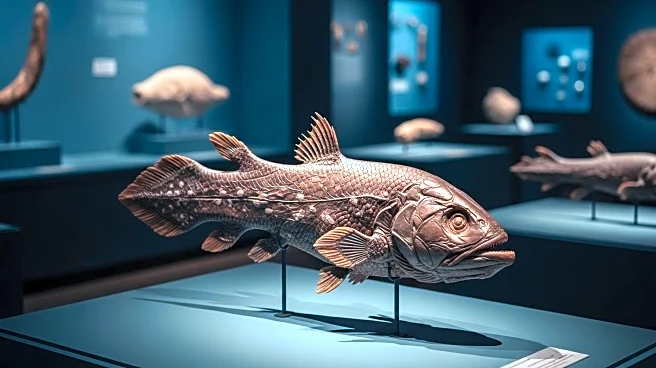What's Happening?
Researchers from the University of Bristol and the University of Uruguay have discovered multiple new species of coelacanths, a type of 'living fossil' fish, in museum collections across the UK. These fossils, dating back to the end of the Triassic Period approximately 200 million years ago, were previously misidentified as belonging to other species. The study, published in the Journal of Vertebrate Paleontology, reveals that these specimens had been overlooked for over 150 years. Jacob Quinn, a researcher involved in the study, used X-ray scans to confirm the identifications, finding that many fossils previously thought to be from the small marine reptile Pachystropheus were actually coelacanths. The fossils belong to the extinct Mawsoniidae group but are closely related to modern coelacanths.
Why It's Important?
The discovery of these coelacanth fossils is significant as it enhances the understanding of ancient marine life and vertebrate evolution. Coelacanths are considered 'living fossils' due to their long history and minimal evolutionary changes over millions of years. This finding provides new insights into the biodiversity and ecological dynamics of the Triassic period, particularly in the region that is now the UK. The research also highlights the importance of re-evaluating museum collections, which may hold undiscovered specimens that can contribute to scientific knowledge. This could lead to a reassessment of other fossil collections worldwide, potentially uncovering more hidden species.
What's Next?
The study suggests further examination of museum collections to identify other misclassified fossils, which could lead to additional discoveries. Researchers may also explore the ecological roles of these newly identified coelacanth species in their ancient environments. The findings could prompt more detailed studies on the evolutionary history of coelacanths and their adaptation strategies over time. Additionally, the research may encourage museums to invest in advanced technologies like X-ray scanning to aid in the accurate identification of fossils.
Beyond the Headlines
This discovery raises questions about the accuracy of historical fossil classifications and the potential for overlooked specimens in museum collections. It underscores the need for continuous scientific scrutiny and technological advancements in paleontology. The study also highlights the interconnectedness of species in ancient ecosystems, as evidenced by the mistaken identity between coelacanths and Pachystropheus. This could lead to a deeper understanding of predator-prey relationships and ecological interactions during the Triassic period.












